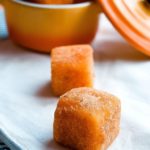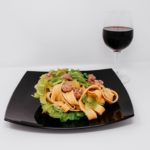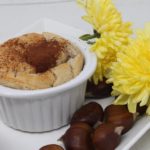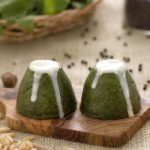FRIED CUSTARD, ANOTHER ITALIAN MARVEL.

Fried custard is a versatile dish. According to where you are in Italy, it has different variations: it is considered mainly as an appetizer in the Marche and Emilia regions, a part of a sumptuous mixture of fried treats like apples, stuffed fried olives (olive all’ascolana), different meats, vegetables and zucchini flowers. The different components vary according to seasonal availability. There are also slight differences in the batter for this fried appetizer. Our ancestors, who probably had iron clad stomachs, created these dishes in times when there was no heating in the houses, and everyone had a very active life.
A question that many foreign clients ask is “Do Italians really eat all these courses and food in a single meal?” The average person of my generation cannot, unless there is a special occasion. However, we enjoy offering our guests a taste of the richness and variety of Italian cuisine. A generous attempt that is sometimes misunderstood as trying to kill them with kindness through food.
In Venice, this is considered a Carnival dish and it is part of an incredible variety of fried sweets that Italians adore. Like cenci (link ad altra ricetta), it is part of a collection of fried recipes.
Prep Time: 10 minutes | Cooking Time: 25 minutes | Total Time: 35 minutes | Yield: Makes 8 servings.
Ingredients for the custard
- ½ cup (100 g) white sugar plus more for sprinkling after frying.
- 3 medium egg yolks
- 4 tablespoons (35 g) pastry or 00 flour
- ¼ cup (35 g) corn starch
- 2¼ cups whole milk
- 1 vanilla bean, split lengthwise, or 1 tsp vanilla extract
- 2 or 3 strips of organic lemon zest
Ingredients for the batter and frying
- 1½ cups breadcrumbs
- 2 medium eggs
- sunflower oil for frying
Instructions
Gently whisk egg yolks, eggs, corn starch, flour and sugar in a saucepan until smooth, then whisk vigorously until light in colour, 1–2 minutes. Whisking constantly, gradually add the milk in a steady stream; scrape the sides of the saucepan. Scrape in vanilla seeds discarding the pod or add vanilla extract. Add lemon zest. Cook mixture over medium heat, whisking constantly, until it starts to thicken. Continue whisking vigorously until the mixture coats the back of a spoon, 6–10 minutes. Immediately remove the custard from heat (do not bring to a boil). Remove and discard lemon zest.
Using a rubber spatula, pour the custard into a baking dish lined with parchment paper.
Let it cool.
Slide a knife around the sides of custard to loosen, cover with a plate and flip over onto the plate. Peel away the parchment paper and cut into cubes or diamonds.
Pour breadcrumbs into a shallow bowl or on a piece of kitchen paper.
Break the eggs in a bowl and whisk. Using your fingers, dip each cube in the egg mixture, then coat with breadcrumbs, shaking off any excess.
Fry until they are golden, and sprinkle with some sugar.
Make Ahead
The custard can be cooked and left in the dish one day ahead.








